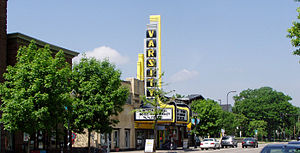Dinkytown
Dinkytown
Dinkytown, USA | |
|---|---|
Commercial District | |
 The Varsity Theater on 4th Street SE | |
 Dinkytown is within the Marcy-Holmes neighborhood of the U.S. city of Minneapolis | |
| Coordinates: 44°58′51″N 93°14′10″W / 44.98083°N 93.23611°W | |
| Country | United States |
| State | Minnesota |
| County | Hennepin |
| City | Minneapolis |
| Neighborhood | Marcy-Holmes |
| Branded | 1940s |
| Founded by | Unknown |
| Named for | Grodnik or Dinkys |
| City Council Ward | 2 |
| Government | |
| • Councilmember | Robin Wonsley |
| Elevation | 830 ft (253 m) |
| Time zone | UTC-6 (CST) |
| • Summer (DST) | UTC-5 (CDT) |
| Area code | 612 |

Dinkytown is a commercial district within the Marcy-Holmes neighborhood in Minneapolis, Minnesota. Centered at 14th Avenue Southeast and 4th Street Southeast, the district contains several city blocks occupied by various small businesses, restaurants, bars, and apartment buildings that house mostly University of Minnesota students. Dinkytown is along the North side of the University of Minnesota Twin Cities East Bank campus.[3]
Notable landmarks[edit]
Notable landmarks include the Dinkydome (a former theological seminary converted to a food court, which sometime later was converted into loft space), the Loring Pasta Bar (formerly Gray's Campus Drug and also the building where Bob Dylan lived in Minneapolis), Al's Breakfast (arguably the city's smallest restaurant), and the Varsity Theater. It's also the location of the second store opened by Richard M. Schulze called "Sound of Music", which later became Best Buy and is now closed.[4]
Notable establishments[edit]
The former Marshall-University High School on the corner of 14th Avenue and 5th Street was closed in 1982 due to changing city population demographics and was purchased and converted into the University Technology Enterprise Center (UTEC) for startups.[5] The building was razed in 2013, and today the location is home to The Marshall, an apartment building for University students. The Chateau co-op built their brutalist-style 22-story apartment in 1973 at 13th Avenue Southeast and 5th Street Southeast.[6]
History[edit]
This section needs additional citations for verification. (August 2013) |
The City of Minneapolis' Heritage Preservation designated a portion of the area as the Dinkytown Commercial Historic District in 2015, due to its significance in the history of streetcar development.[7] The historic district covers an area roughly two blocks around, surrounding the intersection of 14th Avenue Southeast and 4th Street Southeast.[8]
The name Dinkytown is of uncertain origin, although it was in definite use by 1948, when the Dinkytown Business Association formed. Stories regarding the origin of the name include
- The streetcars, called Dinkys, that used to provide transit throughout the area.
- The theatre in Dinkytown had only four rows of seats, and for years was known as "The Dinky Theater." Shortly thereafter, it was just "The Dinky."
- It's a small (dinky) town-like area; everything is within walking distance.
- The Loring Pasta Bar, previously Gray's Drug on 14th Avenue Southeast and 4th Street Southeast, has the name of an early owner carved in cement over the doorway: "Grodnik." Theories claim this means a small (or dinky) town, under the claim that "Grod" means "town" and "-nik" is the diminutive form. Another possible translation (from Polish and Belarusian) is "gardener"; "grod" meaning "garden", and"-nik" as a person-reference, giving "one who gardens".[9]
References[edit]
- ^ "Twin Cities Region Population and Household Estimates, 2006" (PDF). Metropolitan Council. 2006-04-01. Archived from the original (PDF) on 2007-08-08. Retrieved 2007-07-24.
- ^ "Table 2: Population Estimates for the 100 Most Populous Metropolitan Statistical Areas Based on July 1, 2006 Population Estimates: April 1, 2000 to July 1, 2006" (PDF). U.S. Census Bureau. 2007-04-05. Archived from the original (PDF) on 2007-06-15. Retrieved 2007-04-16.
- ^ Weber, Tom; Kaiser, Emily (July 9, 2015). "The Dinkytown history you don't know: Three stories". Minnesota Public Radio News. Retrieved July 13, 2015.
- ^ "Self-guided Dinkytown History Tour". Dinkytown Business Alliance. Retrieved 2019-02-11.
- ^ Sacarelos, Callie (18 July 2012). "Apartments could replace Dinkytown's UTEC building". Minnesota Daily. Archived from the original on 22 October 2013. Retrieved 22 October 2013.
- ^ "About Us". Riverton Community Housing. Retrieved 22 October 2013.
- ^ "Dinkytown Commercial Historic District". Resident Services. City of Minneapolis. Retrieved 23 April 2024.
- ^ Community Planning and Economic Development (July 10, 2015). "Dinkytown Commercial Historic District" (PDF). City of Minneapolis. Retrieved 23 April 2024.
- ^ "About Dinkytown". Dinkytown. Archived from the original on March 19, 2011. Retrieved 20 Mar 2015.
External links[edit]
- Official Website of the Dinkytown Business Alliance Current resources for the Dinkytown community (formerly the Dinkytown Business Association).
- Marcy-Holmes Neighborhood Association Dinkytown is a commercial district, and one of the 5 character areas, of the Marcy-Holmes neighborhood.
- Lileks.com -- University of Minnesota pages—contains information and reminiscence about Dinkytown, by Star Tribune columnist James Lileks
- The Dinkytown Project
- Dinkytown Hub Archived 2015-04-12 at the Wayback Machine Contains information about Dinkytown including a complete list of all businesses.
Further reading[edit]
- Designation Study for Dinkytown Historic District Archived 2017-02-02 at the Wayback Machine
- Violent, colorful protests in Dinkytown in 1970 at the Wayback Machine (archived February 9, 2012)
- MN Daily article at archive.today (archived January 15, 2008)
